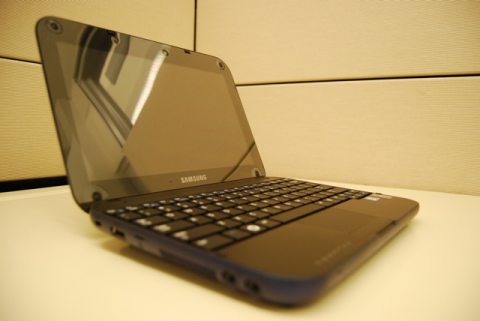Samsung Go netbook: Balanced, for a big bounty [review]

The Samsung Go blows away every stereotype you've ever had about a netbook.
On the outside, it's got a look all its own, with a marshmallow-like exterior and a bevy of colors. Open, you'll find an edge-to-edge display, a chiclet-style keyboard (think Apple and Sony) and a refinement that defies any "toy" connotation you may have applied to the netbook segment.
Once you see its price tag, you'll know it's no toy.
The aptly-named Go is a pleasure to have, hold and use. Available in black, midnight blue, a coral color and "mint" (aqua, if you will), the Go N310 is coated in a rubberized finish of that color, lending the device a pleasing grippiness I came to enjoy.
[Image Gallery: Samsung Go netbook]
Inside, fit and finish were impeccable for a netbook. While I wasn't a fan of the matte black plastic on the inside -- it felt a little basic for me -- the spaces in between panels were extremely narrow, and there was a smoothness, a simplicity to the design. Better yet, I had less trouble acclimating to the Go's small keyboard than I have on other 12-inch and smaller machines thanks to its even, regimented spacing.
The trackpad was slightly less pleasing. A bit rubbery for my taste, the pad felt a bit "sticky" when trying to use it. Interestingly, the trackpad's buttons are not demarcated by a separate line, instead increasing in give as you apply pressure toward the edges of the buttons, rocker-style. I appreciate the look, but the design choice makes for difficult clicking without spreading one's fingers out unnecessarily.
Inside you'll find 1 GB of 800MHz DDR2 memory, a 250GB 5,400 RPM hard drive, Intel GMA 950 integrated graphics, 802.11 b/g Wi-Fi and Bluetooth connectivity.
Outside, a 10.1-inch edge-to-edge wide-screen LED display offers 1,024x600 native resolution, and you'll find VGA-out, stereo speaker and audio in jacks, three USB 2.0 ports, an SD card reader, a DVD burner and an Ethernet port, some of which are hidden along the edge of the device.
The netbook itself is light, but loses its featherweight once you place the hefty but well-integrated battery in its slot underneath its bottom side. As such, the device is a little back-weighted, and will tip a bit in your lap if you're a particularly tall person.
At 2.9 lbs, this 10-inch netbook is about the weight of the 13-inch MacBook Air. But that's comparing oranges to apples.
Booting up the Go was, appropriate to its name, very fast, and impressive for a Windows XP machine running on a 1.6GHz Intel Atom N270 processor. Unfortunately, once the system was available, it was a blast from the past: Windows XP. (Windows 7, of course, is just around the corner.)
I didn't like that my "new" netbook included 16 icons on the desktop by default (My Documents, Computer, Network Places, Recycle Bin and Internet Explorer, perhaps; but Adobe Reader, Easy Network Manager, McAfee Security, Samsung recovery tools, CyberLink YouCam and SkyDrive, no thanks). But startup and shutdown were snappy, and the battery's endurance was most welcome (at 85% capacity, it read more than 5 and a half hours left).
As with any well-equipped netbook, performance was reasonable with modest use. Web surfing, e-mail, IMs and document work were all acceptable on this machine, while streaming media exposed its limits.
The Go, then, is probably the most well-rounded notebook on the market. Until you reach its price tag: $479.
That's a lot of green for a netbook, especially one that doesn't have an SSD or anything particularly special inside.
In fact, I thought I'd conduct an informal survey, so I asked around the CBS offices what people would pay for the Go without telling them what it was or how much it cost.
One woman said no more than $400, because "HP sells the mini for a little bit more and that's better than this." (The HP mini with Windows XP starts at $329.)
Another man -- who used to work for Samsung, ironically -- said "no more than two, three hundred [dollars]." When I told him the price, he just let out a sigh and shook his head.
That's the question that dogged me during testing of the Go: Why has Samsung positioned this netbook so high? Price can reflect performance, exclusivity or desirability. But the Go doesn't have any remarkable components inside or out. It's not twelve inches, it's not particularly "executive" in feel, and it's manufactured by a less well-known brand in the U.S. than, say, Dell, HP or Acer.
The Samsung Go is a well-made, well-proportioned netbook. But at $479, it simply does not compute.
